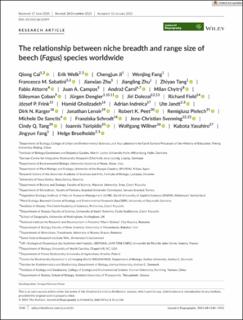Bitte benutzen Sie diese Kennung, um auf die Ressource zu verweisen:
https://doi.org/10.21256/zhaw-22380| Publikationstyp: | Beitrag in wissenschaftlicher Zeitschrift |
| Art der Begutachtung: | Peer review (Publikation) |
| Titel: | The relationship between niche breadth and range size of beech (Fagus) species worldwide |
| Autor/-in: | Cai, Qiong Welk, Erik Ji, Chengjun Fang, Wenjing Sabatini, Francesco M. Zhu, Jianxiao Zhu, Jiangling Tang, Zhiyao Attorre, Fabio Campos, Juan A. Čarni, Andraž Chytrý, Milan Çoban, Süleyman Dengler, Jürgen Dolezal, Jiri Field, Richard Frink, József P. Gholizadeh, Hamid Indreica, Adrian Jandt, Ute Karger, Dirk N. Lenoir, Jonathan Peet, Robert K. Pielech, Remigiusz De Sanctis, Michele Schrodt, Franziska Svenning, Jens‐Christian Tang, Cindy Q. Tsiripidis, Ioannis Willner, Wolfgang Yasuhiro, Kubota Fang, Jingyun Bruelheide, Helge |
| et. al: | No |
| DOI: | 10.1111/jbi.14074 10.21256/zhaw-22380 |
| Erschienen in: | Journal of Biogeography |
| Band(Heft): | 48 |
| Heft: | 5 |
| Seite(n): | 1240 |
| Seiten bis: | 1253 |
| Erscheinungsdatum: | 16-Mär-2021 |
| Verlag / Hrsg. Institution: | Wiley |
| ISSN: | 0305-0270 1365-2699 |
| Sprache: | Englisch |
| Schlagwörter: | Climatic niche; Co-occurrence data; Deciduous species; Fagus; Geographical range size; Vegetation-plot data; Niche breadth; Temperate forest flora; Niche evolution; Phylogenetic signal |
| Fachgebiet (DDC): | 580: Pflanzen (Botanik) |
| Zusammenfassung: | Aim: This work explores whether the commonly observed positive range size–niche breadth relationship exists for Fagus, one of the most dominant and widespread broad-leaved deciduous tree genera in temperate forests of the Northern Hemisphere. Additionally, we ask whether the 10 extant Fagus species’ niche breadths and climatic tolerances are under phylogenetic control. Location: Northern Hemisphere temperate forests. Taxon: Fagus L. Methods: Combining the global vegetation database sPlot with Chinese vegetation data, we extracted 107,758 relevés containing Fagus species. We estimated biotic and climatic niche breadths per species using plot-based co-occurrence data and a resource-based approach, respectively. We examined the relationships of these estimates with range size and tested for their phylogenetic signal, prior to which a Random Forest (RF) analysis was applied to test which climatic properties are most conserved across the Fagus species. Results: Neither biotic niche breadth nor climatic niche breadth was correlated with range size, and the two niche breadths were incongruent as well. Notably, the widespread North American F. grandifolia had a distinctly smaller biotic niche breadth than the Chinese Fagus species (F. engleriana, F. hayatae, F. longipetiolata and F. lucida) with restricted distributions in isolated mountains. The RF analysis revealed that cold tolerance did not differ among the 10 species, and thus may represent an ancestral, fixed trait. In addition, neither biotic nor climatic niche breadths are under phylogenetic control. Main Conclusions: We interpret the lack of a general positive range size–niche breadth relationship within the genus Fagus a s a r esult of t he w idespread d istribution, high among-region variation in available niche space, landscape heterogeneity and Quaternary history. The results hold when estimating niche sizes either by fine-scale co-occurrence data or coarse-scale climate data, suggesting a mechanistic link between factors operating across spatial scales. Besides, there was no evidence for diverging ecological specialization within the genus Fagus. |
| URI: | https://digitalcollection.zhaw.ch/handle/11475/22380 |
| Volltext Version: | Publizierte Version |
| Lizenz (gemäss Verlagsvertrag): | CC BY 4.0: Namensnennung 4.0 International |
| Departement: | Life Sciences und Facility Management |
| Organisationseinheit: | Institut für Umwelt und Natürliche Ressourcen (IUNR) |
| Enthalten in den Sammlungen: | Publikationen Life Sciences und Facility Management |
Dateien zu dieser Ressource:
| Datei | Beschreibung | Größe | Format | |
|---|---|---|---|---|
| 2021_Cai-et-al_The-relationship-between-niche-breadth-and-range-size-of-beech-Fagus-species-worldwide.pdf | 2.03 MB | Adobe PDF |  Öffnen/Anzeigen |
Zur Langanzeige
Cai, Q., Welk, E., Ji, C., Fang, W., Sabatini, F. M., Zhu, J., Zhu, J., Tang, Z., Attorre, F., Campos, J. A., Čarni, A., Chytrý, M., Çoban, S., Dengler, J., Dolezal, J., Field, R., Frink, J. P., Gholizadeh, H., Indreica, A., et al. (2021). The relationship between niche breadth and range size of beech (Fagus) species worldwide. Journal of Biogeography, 48(5), 1240–1253. https://doi.org/10.1111/jbi.14074
Cai, Q. et al. (2021) ‘The relationship between niche breadth and range size of beech (Fagus) species worldwide’, Journal of Biogeography, 48(5), pp. 1240–1253. Available at: https://doi.org/10.1111/jbi.14074.
Q. Cai et al., “The relationship between niche breadth and range size of beech (Fagus) species worldwide,” Journal of Biogeography, vol. 48, no. 5, pp. 1240–1253, Mar. 2021, doi: 10.1111/jbi.14074.
CAI, Qiong, Erik WELK, Chengjun JI, Wenjing FANG, Francesco M. SABATINI, Jianxiao ZHU, Jiangling ZHU, Zhiyao TANG, Fabio ATTORRE, Juan A. CAMPOS, Andraž ČARNI, Milan CHYTRÝ, Süleyman ÇOBAN, Jürgen DENGLER, Jiri DOLEZAL, Richard FIELD, József P. FRINK, Hamid GHOLIZADEH, Adrian INDREICA, Ute JANDT, Dirk N. KARGER, Jonathan LENOIR, Robert K. PEET, Remigiusz PIELECH, Michele DE SANCTIS, Franziska SCHRODT, Jens‐Christian SVENNING, Cindy Q. TANG, Ioannis TSIRIPIDIS, Wolfgang WILLNER, Kubota YASUHIRO, Jingyun FANG und Helge BRUELHEIDE, 2021. The relationship between niche breadth and range size of beech (Fagus) species worldwide. Journal of Biogeography. 16 März 2021. Bd. 48, Nr. 5, S. 1240–1253. DOI 10.1111/jbi.14074
Cai, Qiong, Erik Welk, Chengjun Ji, Wenjing Fang, Francesco M. Sabatini, Jianxiao Zhu, Jiangling Zhu, et al. 2021. “The Relationship between Niche Breadth and Range Size of Beech (Fagus) Species Worldwide.” Journal of Biogeography 48 (5): 1240–53. https://doi.org/10.1111/jbi.14074.
Cai, Qiong, et al. “The Relationship between Niche Breadth and Range Size of Beech (Fagus) Species Worldwide.” Journal of Biogeography, vol. 48, no. 5, Mar. 2021, pp. 1240–53, https://doi.org/10.1111/jbi.14074.
Alle Ressourcen in diesem Repository sind urheberrechtlich geschützt, soweit nicht anderweitig angezeigt.